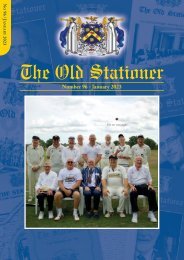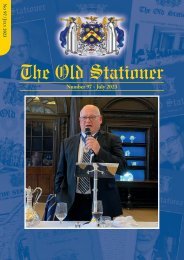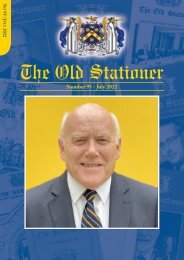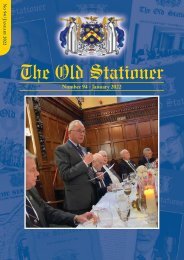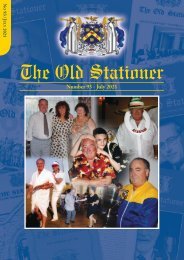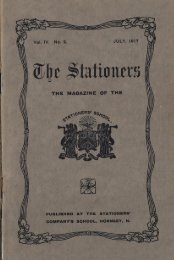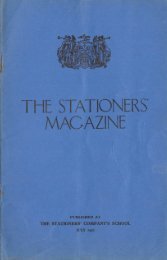OSAmag81
You also want an ePaper? Increase the reach of your titles
YUMPU automatically turns print PDFs into web optimized ePapers that Google loves.
T h e O l d S t a t i o n e r - N o 8 1<br />
Further information from the Sheffield Master Cutler advised<br />
that a) all recipients and their escorts were invited to a lunch in<br />
Cutler's Hall after the service and b) the Cutler's Company was<br />
having two special chairs made for the service, for the Queen and<br />
the Duke of Edinburgh by a Company member, using Sheffield<br />
stainless steel. These would remain in the cathedral. The Cutler's<br />
Hall, which is directly opposite the cathedral, was to be used for<br />
the recipients to be received and duly identified before being<br />
taken across to their seats.<br />
The Almoner pointed out that we were not expected to give the<br />
Queen anything in return. Apparently on one occasion an elderly<br />
lady presented her with a jar of homemade marmalade after<br />
receiving the purses!<br />
And so to the great day. Needless to say, my wife Hazel had a<br />
new outfit, and as the street was closed to traffic, we could not<br />
take cars UP to the doors of the Cutler's Hall and had to walk<br />
the final 200 yards. We hoped that the weather would be kind to<br />
her outfit and my suit, and this proved to be the case as although<br />
cold it was dry and sunny. We were taken across to the Cathedral<br />
watched by the crowds gathered The Queen arrived spot on 11.0<br />
am, with an escort of Yeomen of the Guard. There were four<br />
processions, the Cathedral's, the Ecumenical, The Queen's and<br />
The Royal Almonry. The Choirs of the Chapel Royal and<br />
Cathedral were magnificent, and the music (I gather chosen by<br />
the Queen) included Handel's stirring "Zadoc the Priest" which<br />
is sung at coronations. During the service the Queen went twice<br />
round the cathedral handing the Maundy money to each of us<br />
personally. like many others I was surprised at how petite she<br />
seemed. Amazingly, despite all that had to be achieved the<br />
processions out were right on 12 noon (perhaps because there<br />
was no sermon i), with the Queen signing the Visitor's Book at<br />
the Cathedral door, following which she was greeted by a crowd<br />
estimated at 10,000, and went across to a Civic lunch at the<br />
nearby Town Hall.<br />
The irony for me was that the cost of my wife's new outfit for the<br />
event would have qualified me for assistance under the heading<br />
of destitute! But regardless, the occasion was a memory of a<br />
lifetime.<br />
Rev Brian Cranwell after receiving Maundy Money from the Queen in<br />
Sheffield Cathedral, with his wife Hazel.<br />
Music at Stationers'<br />
Your article about Dr David Clover, Director of Music at<br />
Stationers’ reminded me of a coincidence that happened<br />
only 3-4 years ago in Sheffield.<br />
I was talking to another retired clergyman named John<br />
Collie, and in the course of the conversation he mentioned<br />
he had been at Highgate School. When I told him I had<br />
been at Stationers’ he said “Oh, my father taught music at<br />
Stationers’ for some years”. I realised that his father was<br />
Norman Collie who ran the choir of which I was a member<br />
at Stationers’. He had the nickname of ‘Hamilton’ though I<br />
have no idea why.<br />
This choir was invited to sing at St Paul’s Cathedral at the<br />
first post war Stationers’ Hall crypt service on Ash<br />
Wednesday in 1946. I still remember the first two lines of<br />
the anthem we sang with its tune but have no remembrance<br />
of the composer.<br />
When John died a memorial service was held for him in<br />
the church where he had been vicar for many years. During<br />
the service two of John’s grandchildren played an<br />
instrumental piece “Romance” written by Norman Collie<br />
for his daughter’s 21st birthday.. Later, at the bun fight<br />
following I told the grandchildren I remembered their<br />
great grandfather. They must have thought I was as old as<br />
Methuselah!<br />
I remember mention of Clover in the Sheffield press when<br />
he ran the youth choir. I wish I had known his connection<br />
with Stationers. The musical side of life only consisted of<br />
the choral practice one hour a week at Stationers in my day.<br />
Rev. Brian Cranwell<br />
Promotional programme to<br />
encourage membership of the<br />
Stationers’ Company<br />
Our President was recently a guest at a Master and Wardens’<br />
Luncheon at the Stationers’ Hall. When invited to speak, he<br />
recalled his first visit to the Hall in 1966 as a member of the<br />
school choir after singing the Ash Wednesday service in the<br />
crypt of St. Paul’s Cathedral in the memory of John Norton who<br />
died in 1612.<br />
His comments reminded me that our relationship with the<br />
Worshipful Company of Stationers and Newspaper Makers not<br />
only takes us back to the days of our teens and the opening of our<br />
school in 1861, but it also links us to the beginnings of the<br />
printing industry in 1403.<br />
There are 110 Livery Companies in the City of London, all<br />
playing a part in maintaining the traditions of each guild and<br />
industry from which they were created. Today, not only do these<br />
companies provide a wide variety of social gatherings and a<br />
network of business contacts, but there is also a strong ethic of<br />
support for both charities and educational establishments.<br />
Collectively, the Livery Companies of London donate over £50<br />
million per year which is exemplified by the current investment<br />
by the Stationers’ Company in the Stationers Crown Woods<br />
Academy.<br />
17



